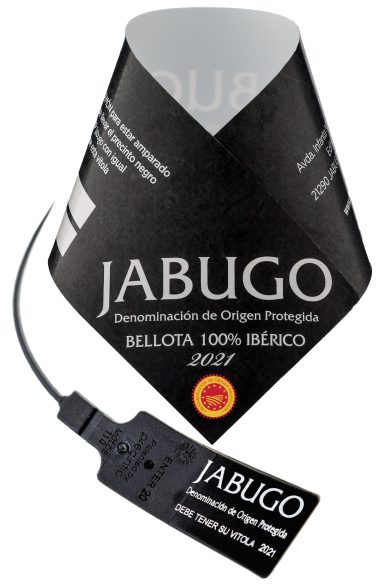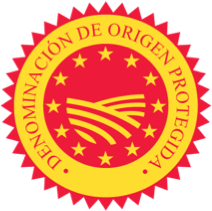PDO
Jabugo.
Naming a feeling.
Jabugo is the name registered by the European Union to designate, protect and certify the quality and origin of ham shoulders and hind legs, that are dried and matured in natural bodegas in the villages within the Sierra de Aracena and Picos de Aroche Natural Park. All products under PDO Jabugo come from 100% Iberian pigs reared and left to roam freely in dehesa pastures.
Geographical
context.
Where the magic happens.
The area where the 100% Iberian pigs are reared and fattened is within the bounds of holm oaks, gall oaks and cork trees dehesas in Badajoz and Caceres (Extremadura) and Cadiz, Cordoba, Huelva, Malaga and Seville (Andalusia).
The dehesa is an agrosilvopastoral ecosystem that has an important biodiversity.
Ham shoulders and hind legs are aged and cured in an area spanning 31 municipalities, (72 villages and hamlets), which make up an inhabited rural landscape within the Sierra de Aracena and Picos de Aroche Natural Park, whose dehesas are classified as a biosphere reserve by UNESCO. The registered bodegas can be found here.
Designation
of quality.
A unique designation of the utmost quality.
PDO Jabugo ham shoulders and hind legs are those that have achieved a harmony of organoleptic properties, especially an aromatic richness as a result of the following characteristics:
- Purebred.
- Pigs are free range and only feed on acorns and natural pastures in the dehesas during the fattening period.
- Very slow curing in unique microclimate conditions.

Method.
A sophisticated 'slow' process.
The stockbreeder is the first person involved in the process, and does not only look after the pigs but also their environment: the dehesa pasture.
The dehesa is a high biodiversity ecosystem with a tree layer, shrub layer and herbaceous layer.
In Sprig, wind-pollination takes place after the holm oaks, gall oaks and cork trees have blossomed resulting in fertilisation.
The 100% Iberian pigsthat are more than a year old are given PDO Jabugo ear tags.
In Autumn, the montanera stage starts: Pigs have a feast of ripe acorns on the ground and natural pastures, and plenty of hectares of space for each of them.
In winter, The pigs go to slaughter and a PDO Jabugo seal is placed on each leg.
The expert ham producer is the second person involved in the process and pays meticulous attention to detail during curing.
The next step is superficial salting; salt is added to preserve the pieces and later washed off.
Then, the salt sets and continues to penetrate the ham during salt balancing, helping it to withstand the natural humidity and temperature.
From this moment on, the pieces react to the unique microclimate conditions.
At the end of spring, in summer and at the start of autumn natural drying occurs. Water content is reduced in the drying sheds located on the top floor of the premises, where the humidity and temperature are controlled by opening and closing the windows.
Then, the ham shoulders and hind legs take their time to mature naturally. The flavour and aroma evolve in the bodega cellars, which are located on the bottom floor of the premises, where humidity and temperature are constant throughout the year.
Finally, all the ham shoulders and hind legs that complete this process, which requires more than four years are given the PDO Jabugo band.

Certification.
Rigorous quality and origin control.
Stockbreaders and ham producers carry out self-monitoring.
The Regulatory Council carries out internal controls, relying on a professional team with the highest qualifications and vast experience.
The Spanish Ministry of Agriculture, Fisheries and Food carries out official controls and certifies the PDO Jabugo pieces.
Formats.
Three fomats,
the same quality.
There are three different formats to meet consumer's preferences.
Whole pieces.
They have the PDO Jabugo seal and label with identical codes, and a label with the authorised bodega's logo.
Boned pieces.
These pieces are fire branded, and therefore they need the PDO Jabugo label and a label with the authorised bodega's logo.
Hand-carved packs.
They have the PDO Jabugo label and a label with the authorised bodega's logo.
The PDO Jabugo seal and band show the year the pigs were slaughtered.
Microclimate.
What makes us unique?
The curing area's unique microclimate is what makes Jabugo different from other hams: high summer day temperatures, mild summer night temperatures and humidity due to storms coming from the Atlantic Ocean that break at the end of autumn, winter and the start of spring in the foothills of the Sierra Morena mountains.